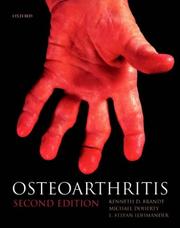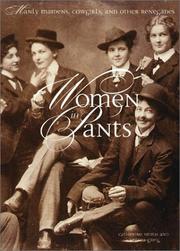| Listing 1 - 5 of 5 |
Sort by
|
Book
ISBN: 8874390327 Year: 2003 Publisher: Genève Musée d'Art et d'Histoire
Abstract | Keywords | Export | Availability | Bookmark
 Loading...
Loading...Choose an application
- Reference Manager
- EndNote
- RefWorks (Direct export to RefWorks)
Art --- armor [protective wear] --- Mannerist [Renaissance-Baroque style] --- anno 1500-1599 --- Italy

ISBN: 0198509677 9780198509677 Year: 2003 Publisher: Oxford Oxford university press
Abstract | Keywords | Export | Availability | Bookmark
 Loading...
Loading...Choose an application
- Reference Manager
- EndNote
- RefWorks (Direct export to RefWorks)
This book looks at the mechanisms for joint failure and how this may be due to abnormal cartilage or disease in underlying tissue. Significant coverage is given to exciting new evidence on disease-modifying drugs and methodologies for their outcomes evaluation. Chapters on both non-surgical and surgical therapy are contained in the management section. The full coverage given in this book allows the physician to consider and choose the right blend of treatment for each patient from the range available whether physical, pharmacologic, surgical or supportive. The book is sympathetic to the significant differences that often exist between the perception of the patient and that of the physician regardign what's important in treatment and coverage is therefore given to the outcome measures needed for optimal evaluation of both.
Osteoarthritis. --- Osteoarthritis --- Degenerative arthritis --- Degenerative joint disease --- Joint disease, Degenerative --- OA (Disease) --- Old age arthritis --- Osteoarthrosis --- Wear and tear arthritis --- Arthritis --- Arthritis, Degenerative --- Osteoarthrosis Deformans --- Arthritides, Degenerative --- Degenerative Arthritides --- Degenerative Arthritis --- Osteoarthritides --- Osteoarthroses --- Arthroses --- Arthrosis
Book
ISBN: 1417599995 9781417599998 Year: 2003 Publisher: Oxford ; New York : Oxford University Press,
Abstract | Keywords | Export | Availability | Bookmark
 Loading...
Loading...Choose an application
- Reference Manager
- EndNote
- RefWorks (Direct export to RefWorks)
This book looks at the mechanisms for joint failure and how this may be due to abnormal cartilage or disease in underlying tissue. Significant coverage is given to exciting new evidence on disease-modifying drugs and methodologies for their outcomes evaluation. Chapters on both non-surgical and surgical therapy are contained in the management section. The full coverage given in this book allows the physician to consider and choose the right blend of treatment for each patient from the range available whether physical, pharmacologic, surgical or supportive. The book is sympathetic to the significant differences that often exist between the perception of the patient and that of the physician regardign what's important in treatment and coverage is therefore given to the outcome measures needed for optimal evaluation of both.
Osteoarthritis. --- Osteoarthritis --- Arthritis --- Rheumatic Diseases --- Joint Diseases --- Musculoskeletal Diseases --- Diseases --- Musculoskeletal System Diseases --- Medicine --- Health & Biological Sciences --- Orthopedic Disorders --- Musculoskeletal Disease --- Orthopedic Disorder --- Arthropathies --- Arthropathy --- Joint Disease --- Rheumatism --- Disease, Rheumatic --- Diseases, Rheumatic --- Rheumatic Disease --- Rheumatology --- Polyarthritis --- Arthritides --- Polyarthritides --- Arthroses --- Arthrosis --- Arthritis, Degenerative --- Osteoarthrosis --- Osteoarthrosis Deformans --- Arthritides, Degenerative --- Degenerative Arthritides --- Degenerative Arthritis --- Osteoarthritides --- Osteoarthroses --- Degenerative arthritis --- Degenerative joint disease --- Joint disease, Degenerative --- OA (Disease) --- Old age arthritis --- Wear and tear arthritis --- Oligoarthritis --- Oligoarthritides
Book
ISBN: 0691238278 Year: 2003 Publisher: Princeton, New Jersey ; Oxford : Princeton University Press,
Abstract | Keywords | Export | Availability | Bookmark
 Loading...
Loading...Choose an application
- Reference Manager
- EndNote
- RefWorks (Direct export to RefWorks)
In the late nineteenth century, Scandinavian urban dwellers developed a passion for a new, utterly modern sort of visual spectacle: objects and effigies brought to life in astonishingly detailed, realistic scenes. The period 1880-1910 was the popular high point of mannequin display in Europe. Living Pictures, Missing Persons explores this phenomenon as it unfolded with the rise of wax museums and folk museums in the largest cities of Denmark, Sweden, and Norway. Mark Sandberg asks: Why did modernity generate a cultural fascination with the idea of effigy? He shows that the idea of effigy is also a portal to understanding other aspects of visual entertainment in that period, including the widespread interest in illusionistic scenes and tableaux, in the "portability" of sights, spaces, and entire milieus. Sandberg investigates this transformation of visual culture outside the usual test cases of the largest European metropolises. He argues that Scandinavian spectators desired an unusual degree of authenticity--a cultural preference for naturalism that made its way beyond theater to popular forms of museum display. The Scandinavian wax museums and folk-ethnographic displays of the era helped pre-cinematic spectators work out the social implications of both voyeuristic and immersive display techniques. This careful study thus anticipates some of the central paradoxes of twentieth-century visual culture--but in a time when the mannequin and the physical relic reigned supreme, and in a place where the contrast between tradition and modernity was a high-stakes game.
Ethnological museums and collections --- Popular culture --- Waxworks --- History --- Scandinavia --- Intellectual life --- A Severed Head. --- Agnosticism. --- Anachronism. --- Anthropomorphism. --- Antique furniture. --- Archive. --- Assassination. --- Autobiography. --- Cataclysm (Dragonlance). --- Cemetery. --- Chamber of Horrors (Madame Tussauds). --- City Museum. --- Complexity. --- Crone. --- Cultural history. --- Curator. --- Deal with the Devil. --- Death mask. --- Death. --- Decapitation. --- Decoy effect. --- Degenerative disease. --- Desecration. --- Diorama. --- Dismemberment. --- Distrust. --- Documenta. --- Double consciousness. --- Dreyfus affair. --- Entrapment. --- Ephemerality. --- Exoticism. --- False evidence. --- First Sorrow. --- Folk museum. --- From Time Immemorial. --- Genre painting. --- Grandparent. --- Grave robbery. --- His Family. --- Historical Association. --- Historical trauma. --- Horror film. --- Hyperreality. --- Illustration. --- Impossibility. --- Infidel. --- Jonathan Crary. --- Karen Blixen. --- Leprosy. --- Linda Williams (film scholar). --- Mail. --- Mannequin. --- Memoir. --- Michael Dummett. --- Michael Fried. --- Mock execution. --- Modernity. --- Morgue. --- Most Secret. --- Museology. --- Museum. --- Mystery of the Wax Museum. --- Neglect. --- Neoromanticism (music). --- New Thought. --- Newspaper. --- Night of the Living Dead. --- Nightmare in Wax. --- Nordic Museum. --- Obsolescence. --- On Cinema. --- Orientalism. --- P. T. Barnum. --- Paul Leni. --- Personal History. --- Portrait photography. --- Random House. --- Religion. --- Romanticism. --- Schocken Books. --- Scientific skepticism. --- Secret photography. --- Semiotics. --- Serial killer. --- Skansen. --- Smithsonian Institution. --- Stockholm City Museum. --- Suicide. --- Superiority (short story). --- Taxidermy. --- The Last Minute. --- The Philosopher. --- Theft. --- Thomas Kuhn. --- Underdevelopment. --- Viewing (funeral). --- Vincent Price. --- Wax museum. --- Wear and tear.

ISBN: 0810945711 9780810945715 Year: 2003 Publisher: New York Harry N. Abrams
Abstract | Keywords | Export | Availability | Bookmark
 Loading...
Loading...Choose an application
- Reference Manager
- EndNote
- RefWorks (Direct export to RefWorks)
'Women in pants' charts an almost forgotten revolution in clothing that radically altered modern society. Featuring a remarkable collection of vintage photographs from the 1850s to the 1920s and tracing a fascinating slice of social history, the book documents many women who deviated from the strict conventions of the time by shedding their tight corsets, bustles, and long skirts in favor of the more rational attire of bloomers, knickers, trousers, and pants. Dress reformers, farmers, miners, ranchers, mountaineers, performers, and sportswomen openly wore pants. Others, resisting the domestic roles of wife and mother, disguised themselves as men to secure higher-paying jobs, join the military, or engage in relationships with other women without interference. And scores of women played with gender identity by cross-dressing for the camera.
Pants --- Women's clothing --- Women's rights --- Women --- 316.37 <45> --- 316.37 <73> --- 391-057 --- 391 "18" --- 391 "19" --- 391.2 --- 391 <41> --- 391 <73> --- 77.041 --- Women's apparel --- Women's wear --- Womenswear --- Clothing and dress --- Dressmaking --- Tailoring (Women's) --- 77.041 Artistieke fotografie. De mens --- Artistieke fotografie. De mens --- 391.2 Klederdracht voor vrouwen. Vrouwenmode --- Klederdracht voor vrouwen. Vrouwenmode --- 391 "19" Kleding. Mode. Sieraden. Volksdracht--20e eeuw. Periode 1900-1999 --- Kleding. Mode. Sieraden. Volksdracht--20e eeuw. Periode 1900-1999 --- 391 "18" Kleding. Mode. Sieraden. Volksdracht--19e eeuw. Periode 1800-1899 --- Kleding. Mode. Sieraden. Volksdracht--19e eeuw. Periode 1800-1899 --- 391 <73> Kleding. Mode. Sieraden. Volksdracht--Verenigde Staten van Amerika. VSA. USA --- Kleding. Mode. Sieraden. Volksdracht--Verenigde Staten van Amerika. VSA. USA --- 391 <41> Kleding. Mode. Sieraden. Volksdracht--Verenigd Koninkrijk van Groot-Brittannië en Noord-Ierland --- Kleding. Mode. Sieraden. Volksdracht--Verenigd Koninkrijk van Groot-Brittannië en Noord-Ierland --- 316.37 <73> Identiteit. Individu en maatschappij. Persoonlijkheid--Verenigde Staten van Amerika. VSA. USA --- Identiteit. Individu en maatschappij. Persoonlijkheid--Verenigde Staten van Amerika. VSA. USA --- 316.37 <45> Identiteit. Individu en maatschappij. Persoonlijkheid--Italië --- Identiteit. Individu en maatschappij. Persoonlijkheid--Italië --- 391-057 Kleding. Mode. Sieraden. Volksdracht--Personen naar hun bezigheden, beroep, opleiding --- Kleding. Mode. Sieraden. Volksdracht--Personen naar hun bezigheden, beroep, opleiding --- Human females --- Wimmin --- Woman --- Womon --- Womyn --- Females --- Human beings --- Femininity --- Pantaloons --- Slacks --- Trousers --- History --- Social conditions --- Clothing --- Developmental psychology --- Sociology of the family. Sociology of sexuality --- History of civilization --- anno 1800-1899 --- anno 1900-1999 --- United States --- United States of America --- Photobook --- Gender roles --- Fashion --- Cross-dressing --- Book
| Listing 1 - 5 of 5 |
Sort by
|

 Search
Search Feedback
Feedback About UniCat
About UniCat  Help
Help News
News